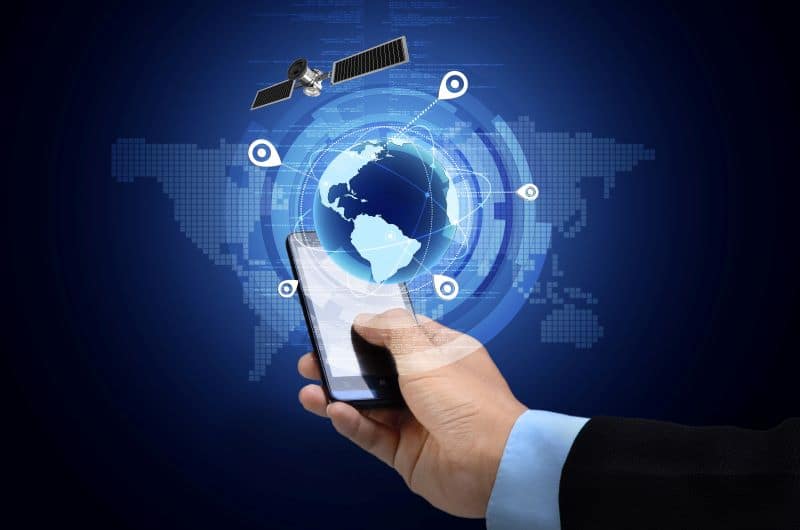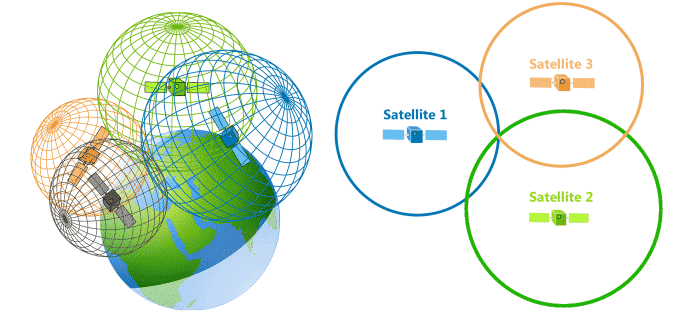Your cart is currently empty!
GPS & EMF: Why You Should & Shouldn’t Be Worried About Location Tracking
Last Updated on October 4, 2023

Modern technology has become more and more complex over the years. Who knew so many different tools could be used in one small pocket-sized device?
A smartphone, for instance, is actually compiled of a variety of sensors that work together to provide all the services and tools we use everyday. From getting to the closest Chick-Fil-A, to tracking our health, our phone is capable of a lot of data-gathering.
The tools responsible for this data-collection include a GPS, accelerometer, gyroscope, magnetometer, barometer, proximity sensor, ambient light sensor, microphone, touchscreen sensors, pedometer, thermometer, and more.
And to think, all of that can fit in the palm of your hand.
How Does Location Tracking Work?
Tracking the phone–or the phone user’s–location has become a very important facet of these sensors. To track our location, the accelerometer, GPS sensor, and pedometer are used. Pedometers rely on the accelerometer and the values it creates to determine distance translated to the number of steps. The accelerometer senses direction and speed, which is tied to movement and location. However, the most critical part of location tracking lies with in the GPS sensor.
Way back before smartphones, in 2005, you couldn’t leave for a road trip without a 5-page step-by-step Mapquest printout or a TomTom or Garmin navigation device. Can you even remember trying to navigate before GPS and Google Maps, when you had to rely on your killer sense-of-direction and gut instincts as you tried to locate nearby roads and points of interest on a map to figure out where you were? It wasn’t that long ago, but going back to that process now seems archaic.
Now, the ability to pinpoint a location and provide directions is wrapped up in the same device we use to make calls and send texts.
How is this all possible, you ask? Well, it’s all thanks to GPS technology.
So, what exactly is GPS technology, how does it work, and what effects can it have on our lives? Keep reading to find out.
What is GPS?

The Global Positioning System, or GPS for short, “provides users with positioning, navigation, and timing services.” GPS is an American product—other countries have their own versions such as the EU’s Galileo and Russia’s GLONASS.
GPS is a system composed of a satellite constellation in the sky, ground stations that use radar to communicate with the satellites, and receivers that use satellite signals to determine your precise location on Earth.
The satellite constellation is located in the medium Earth orbit—from virtually anywhere on the planet, you should be able to view at least four of these satellites (though not with the naked eye; you’d need some help from a telescope).
The original 24 satellites were sent into space during the ’90s. Since then, the U.S. government has launched additional satellites as backup. In 2011, the Air Force added three more slots to the constellation, creating a new network of 27 satellites, improving coverage globally.
Ground facilities track the GPS satellites, monitor their transmission, perform analyses, and send commands and data to the satellites. The network of ground systems is headquartered at Schriever Air Force Base in Colorado. Look at this map to see where all the GPS ground stations are located around the world.
Your GPS receiver, a chip buried inside many different types of devices, from phones, to cars, to dog collars, is listening for signals from the satellites, calculating its distance from them, and then determining exactly where you are, using a method called trilateration.
How GPS Works – Trilateration

What is trilateration?
The hardware of phones and other mobile devices includes GPS receivers as a separate chip, not connected through a cellular network, Bluetooth, or WiFi.
The receiver gets its data from signals sent from at least three of the GPS satellites to trilaterate your position.
Each satellite sends out a signal that can be picked up by a device’s receiver. When that device picks up the signal, it knows the distance between it and the satellite because the satellite broadcasts its location and time.
In theory, you could be located at that distance in any direction from the satellite, forming a circle equal in all directions around the satellite. If you used only one satellite to pinpoint a location, you could be located anywhere on that circle. So, by using information from three satellites to trilaterate a location, it creates three circles of possible locations. These three circles will overlap in just one place to provide the exact location.
GPS is often associated with maps and determining directions, but in reality, it does a lot more. Once your phone is able to determine your location, it unlocks a whole realm of functions and possibilities. You can find out where the device is currently, where it has been, and how fast it is moving.
You can use geotagged Snapchat filters so everyone knows where you’ve posted your selfie, let Uber know where to pick you up, find the closest gas station, track your run, and follow connected devices. GPS trackers can be found in phones, tablets, computers, smart watches, fitness trackers, e-readers, cars, animal collars–the list goes on and on.
An endless number of apps use GPS to help better serve their functions, so much so that we don’t think twice about it (spoiler: you should be thinking twice about what apps are using your location, but more on that later).
Does GPS Emit EMFs?
As you move from place to place, GPS updates your location in real time. This requires constant signals to be sent to your device.
So, is EMF radiation exposure a concern when using GPS?
Well, the GPS chip in the phone or other electronic device is a completely separate chip than your cellular, Wifi, and Bluetooth chips. It doesn’t send data to cell towers, your WiFi network, or other devices (other apps on your phone are responsible for this, but more on that later).
The GPS chip is only responsible for receiving signals from satellites. As a receiver, it does not transmit any data. It’s considered one-way communication, and doesn’t send any data to satellites, compared to other types of technology that are both transmitters and receivers.
The GPS chip does pick up satellite signals, transmitted on two different radio frequencies, L1 (1575.42 Mhz) and L2 (1227.60 MHz). However, since the source is so far away in space, the signal is a very low power level and is not cause for concern.
With that being said, the answer is no. The GPS chip by itself does not create EMF emissions.
Do Apps Using GPS Create EMFs?
Just because the GPS chip is safe, doesn’t mean location tracking is safe. Most people have GPS chips built into phones and other electronic devices, and those devices are chock-full of apps that use your location and send this data via RF transmitters such as your cellular network, WiFi, or Bluetooth. And those can emit harmful radiation, especially when apps are transmitting your location data 24/7.
Running apps, shopping apps, health apps, and travel apps can use your GPS data, and then in turn transmit this data via the cellular or Bluetooth transmitter in your phone, which emits EMF radiation.
For example, Google Maps can access your GPS location, and you can see where you are even without cell phone service, or a WiFi or Bluetooth connection. To actually navigate a route, your phone has to be connected to a cellular signal.
As long as you are in an area that can be accessed by the satellite signals, your GPS will work. You can track your location even 10,000 feet off the ground in an airplane, but due to the Faraday Cage Effect, satellite signals might not be able to penetrate the metal tube you’re sitting inside.
In terms of navigation apps, even when you lose cell phone service, your GPS should still work and follow your position as long as you don’t make a wrong turn. Your phone then has to connect to a cellular signal to be able to recalculate the fastest route.
This means that even in Airplane Mode, when radio antennas are turned off from transmitting data, GPS still works. When your phone is in Airplane Mode, you can still receive GPS information (though the maps require data to download the image). Airplane mode turns off your device’s transmitters. Since GPS does not transmit information–it just receives info–it can still function in Airplane Mode.
So having GPS tracking doesn’t necessarily expose you to EMF radiation. It comes down to what apps are using your location data, and if those apps are connecting to other wireless networks that can increase EMF radiation emissions.
Some apps might be relaying this information to cell towers or other connected devices 24/7 without your knowledge, and this chronic EMF exposure can be harmful for your health.
EMFs have been linked to a whole range of health problems, so it is necessary for you to be aware of what your phone, fitness trackers, or other devices are transmitting during the day or night.
Are There Privacy and Security Issues When Using GPS on Your Phone?
GPS is Hard to Shut Off
Even when your phone is powered off, the GPS chip is still connected to the battery, so it can still function. Thankfully, the GPS chips in our phones hardly use any power, and with your phone off, apps are off, so GPS information cannot be transmitted anywhere. However, to completely disengage the GPS function, you would have to remove the device’s battery (a slight problem for some mobile devices). This is similar to unplugging an appliance for it to stop using power even though it’s turned off.
Security experts agree that it is practically impossible to stop all location tracking on smartphones, since there are multiple ways of tracking, including cell towers, the metadata transmitted from telecommunications, and data logged on our phones.
According to Princeton researchers, even with WiFi, location tracking, and GPS disabled, other sensors in the phone, like air pressure, can still help find the device’s location. This non-GPS method is called the PinMe technique.
There has been a shift in generational thinking surrounding the topic of location tracking as a property right. In a study published in Child Development, researchers found that adults were opposed to someone else tracking their personal device, whereas children “expressed positive evaluations of this behavior.”
This divergent thought could be a result of the prevalence of technology in each generation’s lives. Older generations remember what life was like pre-cell phone, but children are digital natives so they don’t know life without technology. In that sense, adults may perceive GPS tracking as unnecessary or invasive. The younger generations have just accepted GPS tracking to be part of their lives since that is all they know.
Location-sharing can certainly convenient for many: parents keeping track of kids, how many steps you walked and calories you burned, nearby restaurant recommendations, and for businesses to use as market research to best promote correct products to the correct people.
However, hackers and criminals can also use this data for malicious intent. Based on your location data, criminals could determine when you are out running errands, away on vacation, where you work, and your child’s school. They could then target your house for robberies or figure out when your children are alone unsupervised.
In 2016, Kim Kardashian was famously robbed at gunpoint in Paris after the robbers were able to determine her location based on the posts she had shared. Two years later, police in Los Angeles arrested a team of criminals who broke into the homes of Rihanna, Christina Milian, Yasiel Puig of the Dodgers, and Robert Woods of the Rams, as part of a crime ring targeting celebrities when they were away.
Apps Can Exploit Your Location with GPS
Oftentimes, when an app is downloaded, it asks for permission to access different parts of your phone: contacts, camera, microphone, location. Different apps will ask for different permissions.
Some make sense: a photo editing app needs access to your photos so that you can select which one you want to edit. But, does it need access to your location?
During the Pokemon Go craze of 2016, when users signed into the app with their Google account, the game developer, Niantic Inc., requested full access to the phone. This brought to light for many game users the privacy concerns surrounding apps and their access to personal information. What are these app developers and companies doing with this data?
At one point, major phone companies were selling real-time location information from wireless carriers to third parties. Spearheaded by Senator Ron Wyden, in in May 2018, there was a movement to stop the practice of selling such information. In a letter to AT&T, Sen. Wyden called out the company to take “proactive steps to prevent the unrestricted disclosure and potential abuse of private customer data.” Following a lengthy legal battle between AT&T and upset customers, in 2019 the company finally agreed to stop selling the data. Whether or not the company has actually done so is unclear, which is why in early 2020, the Federal Communications Commission proposed fines against the big four data companies for their breach of privacy: $91 million for T-Mobile, $57 million for AT&T, $48 million for Verizon, and $12 million for Sprint. Some people think that the FCC, seen by many as a corrupt government agency, only fined the companies due to public outcry.
In the future, it will be interesting to see how the FCC and government handles data privacy.
GPS Allows a New Type of Phishing
And no, we don’t mean fishing as in a rod, reel, and some bait. Phishing, spelled with a “ph”, is the attempt to obtain financial or other confidential information from Internet (and now phone) users by sending a message with a link to a fake website.
When a person clicks on the link, the people behind the message are able to obtain personal information, oftentimes without the user’s knowledge or consent.
Now, because phones are constantly being tracked, phishing messages may gather location data. How the “phishermen” may use that data is unknown. It’s best to avoid unwittingly giving up personal information—next time you receive a weird text message with an odd-looking link, don’t click on it and delete it immediately.
How the Law Interprets Phone Data Privacy
The Fourth Amendment in the Bill of Rights has been interpreted to protect a person’s right to privacy. There are many grey areas when it comes to applying this right, and one of the major ones encompasses cell phone location data.
In the case Carpenter v. United States, the Supreme Court ruled the government generally needs a warrant to seize historical cell phone location records because it was determined to be a Fourth Amendment search. Cell phone records were deemed to be protected under this right, except in extreme cases. The four dissenting opinions argued that cell phone records would help the government stop dangerous criminals, including murders, rapists, arsonists, and robbers.
However, going forward, the police need a warrant to seize phone data records. While the government is officially prohibited from accessing cell phone records except for rare cases, it’s a scary thought to imagine the reach of the government if they were given all that information on every single person with a cell phone.
If the government knows where you are, it’s easy to put together the puzzle of who you are, taking away any anonymity you might have had.
5 Ways Prevent Being Tracked and Reduce EMF Radiation
- Keep your phone protected. Store your phone in a faraday bag, to prevent all signals (including GPS) from being sent or received. Because there are no signals being sent or received, your device cannot engage its GPS functionality. It will also block EMF frequencies from reaching your body!
- Take the battery out. If you do have a device with a removable battery, take it out when you aren’t using your device. Powering off the phone does not necessarily turn off the GPS receiver; it’s still operating at limited capacity. The only way to completely turn off GPS functions is to remove the power source.
- Put your phone on Airplane Mode at night. Even though this doesn’t turn off GPS, your apps won’t be able to transmit RF signals, which will reduce your EMF exposure at night.
- Leave your phone at home if you don’t need it. That way, some of your movements won’t be tracked, creating a bit more anonymity. Ditching your phone will also reduce your exposure to EMF radiation, which can help you sleep, focus at work, and connect with nature more!
- Be aware of the location settings and preferences of each app. Think twice the next time a photo editing app asks for access to your contacts or location. Check your location settings to make sure unnecessary apps do not have access to your location. Or, you can turn off location tracking completely in your phone settings.
- Download apps that help to monitor your privacy. It may seem counterintuitive to download another app when apps are oftentimes the offenders, but there are actually helpful apps out there that help you maintain your privacy. Privacy Badger is one that blocks invisible trackers. It prevents third parties from tracking your location and what websites you browse.
Related Posts
None found



























